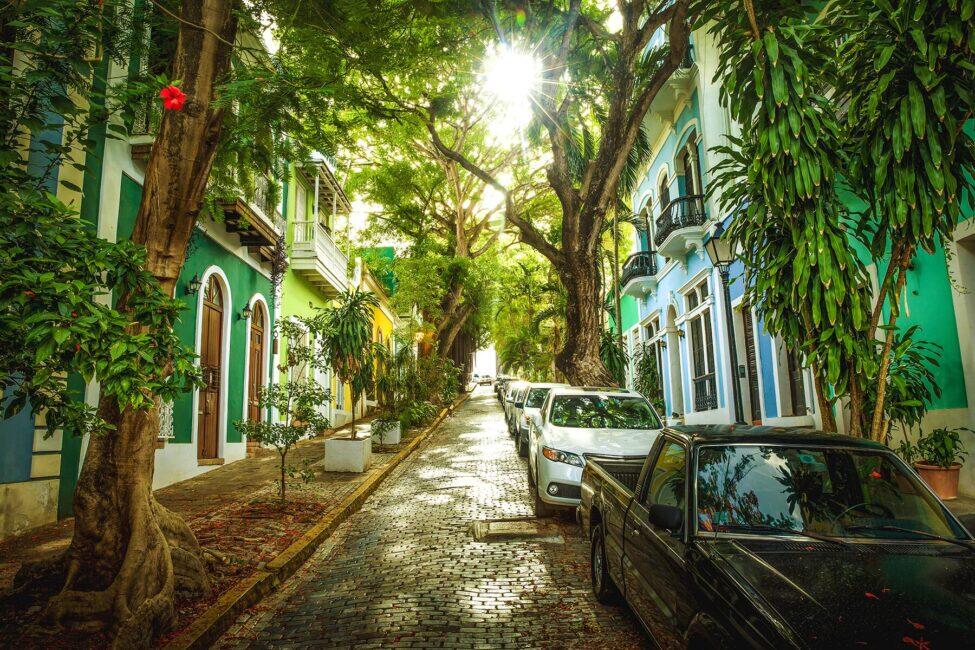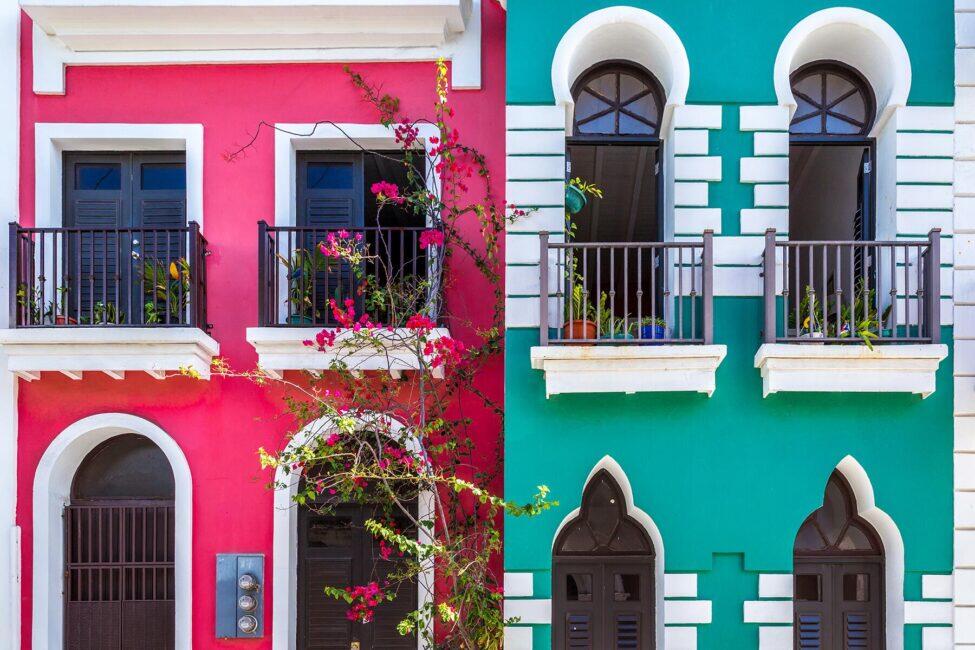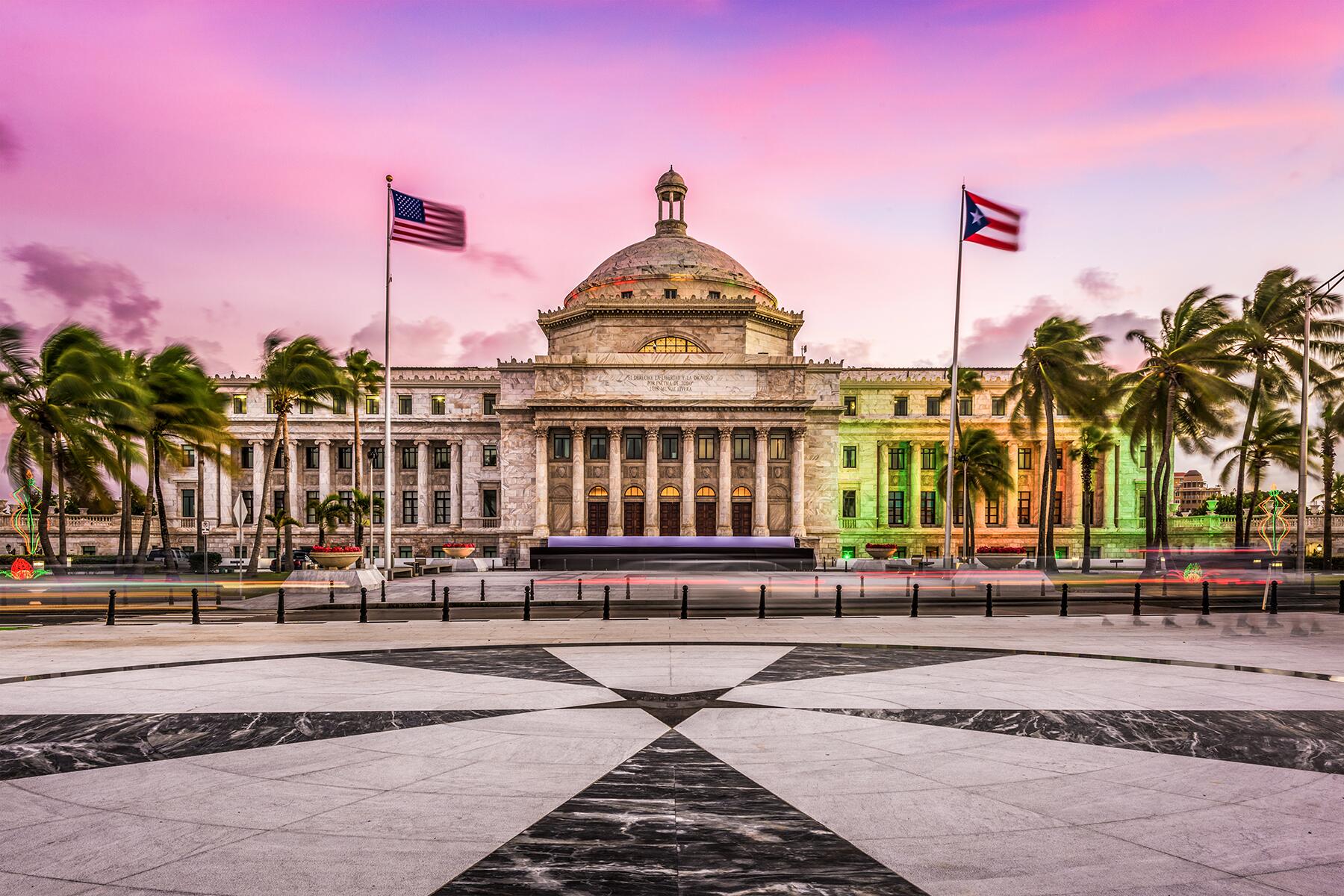In Puerto Rico, Old San Juan will be celebrating its fifth centenary.
I stroll through the great Red Gate, once the main entry into the walled city of San Juan, up the cobbled, tree-shaded Caleta de San Juan, to the grandiose Catedral Basilica Menor de San Juan Bautista. I think back to centuries ago when Spanish conquistadors parked their ships in the San Juan Bay and walked this same way to this very cathedral to thank God for a safe voyage across the Atlantic.
History is everywhere in Old San Juan—from the El Morro and San Cristóbal forts that guarded the city to the Casa Blanca house where Ponce de León was purported to live, to the convent-turned-luxury hotel, El Convento. Even the cracked and faded blue cobblestone streets date back to those early times, cast from furnace slag brought over on Spanish ships as ballast.
Angel Torres has spent his 70 years in Old San Juan. He describes the city as still retaining the buildings where Spanish governors met and where great musicians and artists resided centuries ago. “It’s a place full of stories and legends,” describes Torres. “A city where you discover something new every day.”
Old San Juan is turning 500 this year, making it the oldest city in the United States (Puerto Rico joined the United States in 1898 following the Spanish-American War). The city is celebrating its fifth centenary with a panoply of events that will be ongoing through June 2022. But what does it mean to celebrate 500 years of being colonized?
Recommended Fodor’s Video
When the Spanish first arrived on the island in 1493, led by Christopher Columbus on his second voyage to the New World, they found the Taíno Indians, a subgroup of the Arawak Indians in the Greater Antilles (Cuba, Jamaica, Hispaniola, and Puerto Rico). The Taíno were known for their ceremonial ball courts, the development of a universal language, and the creation of a complicated religious cosmology. They were skilled at agriculture and hunting, as well as sailing, fishing, and navigating. They lived in about 20 villages headed by caciques (chiefs), with anywhere between 20,000 and 50,000 in number, and they called the island Borikén (Great Land of the Valiant and Noble Lord).
“The Taíno thought Columbus was a God and they revered him,” explains Jonathan Caraballo, a guide at Discover Puerto Rico, an integral player in the 500th celebration. “They became his slaves. Then one white man was killed—they had drowned him, then stabbed him—and there was blood. They realized they weren’t Gods, so they rebelled and were killed with guns.”
The Taíno population was drastically reduced from over 20,000 to 4,000 by 1515. Just 30 years later, a bishop counted only 60 Taíno, but soon they were lost, too. “This led us to believe they were assimilated, or the number too negligible to count,” adds Pablo Garcia Smith, a manager, and guide at Spoon Food Tours, which offers authentic culinary tours in Puerto Rico.
Meantime, as the Spanish colonized the island, they moved the capital city (originally established nearby at Caparra) to its current location in 1521, to be closer to the dock when the Spanish galleons arrived. They built stately government buildings, residences, and churches inside a protective wall, the essence of which remains to this day.

The first Africans arrived with the early Spaniards, known as libertos. As the Taínos died off, the Spanish forced Africans to work in gold mining, cultivate crops such as coffee and sugar, and build forts. Eventually, West Africans were kidnapped and brought to the island to work, with slavery finally being abolished in March 1873.
“Christopher Columbus was a tyrant,” admits Caraballo. “[For Puerto Ricans], it’s a love/hate relationship. We mention him in our anthem, but we don’t like him. Only five years ago, the largest statue of him in the world was built in Arecibo. Yes, there was a controversy when it was built, but it was built.”
In speaking with Pablo Garcia Smith, I find he has a different approach—one that I find harder to stomach.
“By virtue of our colonial heritage, we say that’s just the way it was,” adds Smith. “Christopher Columbus was brutal and blood-thirsty, but he was a man of his age. We’re in a different time than we were then. We don’t see anger toward the death of the natives and all that. These events are far removed from us. It doesn’t impact us directly.”
While I find his assessment difficult, what I discovered in speaking with most Puerto Ricans is not a focus on anti-colonial sentiment, per se, but more on a celebration of the island’s different cultures and how they have become blended over the years.
“We are a mix of Taíno, African, and Spanish,” explains Davelyn Tardi, who also works for Discover Puerto Rico. “It’s in our veins at the end of the day.” That is why the island’s culinary and musical traditions are so important because they reverberate with the souls of the ancestors. Take bomba, for example. The drum-driven dance, which also gives its name to the instruments and the musical genre, harks back to 17th-century West Africans enslaved on Puerto Rico’s sugarcane plantations, who used the music for political and spiritual expression.
“African slaves brought to Puerto Rico came from many different cultures and were unable to communicate with each other,” adds Smith. “So maybe they couldn’t understand each other’s words, but they could understand rhythm.”
Bomba evolved through the years, becoming a spiritual link to descendants, so that today, it is played and danced on city terrazzas and at family celebrations, especially at Christmas time. “Bomba is spiritual for Africans,” says Amaury Febre, the director of La Bomba Va. “It represents our ancestors.” As a song and dance built on the resistance and survival of enslaved people in Puerto Rico, it was danced and played more recently during the Black Lives Matter protests, following the death of George Floyd.
Like its music, much of Puerto Rican cuisine also finds its roots in the island’s mélange of cultures. The Spanish brought cilantro, beans, garlic, olives, as well as chicken and pork. Pollo guisado—stewed chicken with spices and vegetables—is one of the most popular dishes reflecting this heritage. The Taínos used many fish, tropical fruits including guava and pineapples, and root crops such as cassava. It’s said that cocina criolla (creole cuisine) dates back to the Taínos. Then you have the plantains, coconuts, sweet bananas, yams, and coffee brought by the Africans, along with the frying method. Tostones (fried plantains) and sancocho (traditional stew with beef, cassava, plantains, and corn) have direct lineage to African ancestors. However, the most popular dish is mofongo—fried green plantains mashed with garlic and pork rinds.
“Mofongo is the iconic food of Puerto Rico,” says Smith. “It traces back to the Angolan Kikongo tribes in Western Africa. Mofongo means ‘smash a great number of things,’ which is what mofongo is. When we say ‘mofongo,’ we are proudly quoting the people of the tribe, of that Kikongo heritage.”

San Juan Gets Ready to Turn 500-Years-Old
As Smith explains, many Puerto Ricans might not be paying much attention to the anniversary. “There’s a lot of distracting things going on right now,” he explains. “Commemorating requires space for people to feel that freedom, to celebrate and go into it fully. Right now—culturally and politically—we’re in a tough moment. It’s hard for people to switch gears to, oh, 500 years, and then allow themselves to wonder: what does that mean for me? People haven’t had the opportunity to do that because of the pandemic and the hurricane. The world keeps burning.”
At the same time, there’s national pride in harboring the oldest city in the United States and its territories. One that’s full of history, both good and bad. As Angel Torres puts it, San Juan’s is a history that has fostered a preponderance of singers, artists, athletes, and scientists. The mix of cultures and traditions that has evolved is the true cause for celebration. This is ultimately what defines San Juan.
San Juan’s 500th–anniversary festivities will occur through June 2022, with scheduled events including music, historical exhibits, cultural events, and artistic presentations. It’s easy and safe to travel to Puerto Rico. All travelers are required to fill out a Travel Declaration Form, including uploading an official vaccination card or proof of either a PCR molecular or Covid-19 antigen test within 72 hours of arrival. All restaurants, bars, hotels, and events require evidence of vaccination. Masks are mandated indoors, regardless of vaccination status. All hotels, restaurants, bars, and events require proof of vaccination or a negative test taken with 72 hours.
The oldest inhabited areas are in the west - much older than San Juan: 700 AD - 1100 AD - The Hopi pueblo village of Oraibi was founded, making it the oldest continuously inhabited town in Arizona (and along with Taos and Acoma Pueblos of New Mexico, one of the oldest continuously inhabited settlements in America). (https://www.ereferencedesk.com/resources/state-early-history/arizona.html)






The author could have written an unbiased article but instead chooses to insert her own Jingo-ist perspective by saying Puerto Rico "joined" the United States. If you mean it was invaded without just cause or provocation, militarily occupied, its populace subjugated and expoited by the USA then yes, but do not think it was done by either free will or with consent of the people.
Additionally the author is uncomfortable with Hispanic people celebrating their Spanish heritage but takes no responbility for American colonialism, both in the United States and abroad, as if the Pilgrims and Jamestown colonists didn't import slaves and wage genocidal warfare upon the natives.
To say Colombus or Ponce de Leon were people of their time is no different than Queen Elizabeth, John Smith or Francis Drake were of theirs. The only reason Spaniards are villified and the English are not is because of American Hispanophobia and the Black Legend.
Next time you try to judge another cultures social traditions, consider what your Thanksgiving dinner really means in terms of colonialism and social justice, then tell me how you think your history is any better.